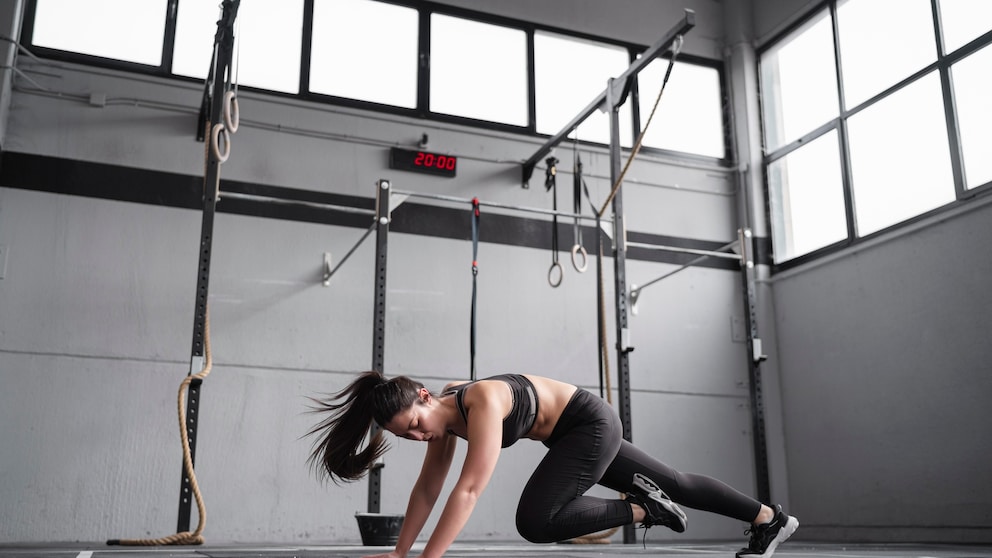April 17, 2025, 12:26 pm | Read time: 5 minutes
Few bodyweight exercises are as versatile as mountain climbers. Nearly the entire body is engaged in dynamic movement during the exercise, and depending on the training focus, both strength and endurance can be specifically enhanced. A personal trainer at FITBOOK explains which variations of the mountain climber exercise are suitable for each goal.
A fit and efficient body is composed of several components. Functional training, in particular, leads to this goal. The focus here is on improving movements from our daily lives and setting multiple stimuli. This includes the mountain climber exercise, where you essentially run in place in a horizontal position. By varying the execution of mountain climbers, we can focus on either strength or endurance.
Overview
Aren’t Mountain Climbers Actually a Cardio Exercise?
We’ve already covered which muscles mountain climbers train and how to perform the exercise correctly. Now, let’s look at variations of this popular exercise that can specifically target strength or endurance. While mountain climbers are generally a cardio exercise, by adjusting factors like speed, frequency, and duration, they can also build strength. “The slower and more controlled, the more mountain climbers become a strength exercise,” Markus Bremen explains to FITBOOK. The focus then shifts to the core. Conversely, “the faster we perform the exercise, the more the cardio aspect is emphasized.”
How Mountain Climbers Become a Strength Exercise
Let’s first focus on building power and strength. According to Bremen, this can be achieved by extending the hold time, which primarily trains the core, shoulder, chest, and leg muscles.
1. “Slow” Mountain Climbers
In the classic basic form, you simply work slower and less explosively. Instead of quickly switching legs, you slowly pull each knee to your chest under tension. Additionally, you extend the hold phases, spending more time under tension to build more strength.
Tip from the personal trainer: Advanced individuals can increase the intensity of mountain climbers by wearing a weighted vest to add resistance to the core, or ankle weights for the same effect.
2. Cross Body Mountain Climbers
As the name suggests, you bring each knee diagonally to the opposite side, slowly and under tension, alternating each time. This primarily activates the oblique abdominal muscles.
As with the first exercise, you could also use a mini band for added resistance around the feet. According to the expert, this significantly increases the strength stimulus. A slower execution further enhances the effect.
3. “Elevated” Mountain Climbers
Changing the foot position can also turn mountain climbers into a strengthening exercise. This means placing your feet on an elevated surface, like a box or bench, instead of the floor or a fitness mat. The upper body bears more weight as the body weight shifts forward, engaging the upper body muscles more intensely.

How to Train Strength and Endurance with Mountain Climbers

How Effective Is EMS Training, and Who Is It Suitable For?

Ralph Siegel Loses 36 Kilograms — What Studies Say about Wegovy and Similar Drugs
Variations That Boost Endurance
Now let’s focus on the original training aspect of mountain climbers: endurance. This is trained through the inherently dynamic and fluid movement, engaging many muscles simultaneously. As a result, the heart rate spikes temporarily, providing the training stimulus that leads to cardiovascular fitness over time. The body adapts and becomes more efficient, which is the essence of endurance training. For our mountain climbers, “the faster, the more it targets endurance,” says Bremen.
According to the expert, two other physical abilities improve as a side effect, which are not aspects of endurance: explosiveness (speed strength) and reactive strength (the ability to quickly regain strength during fast cycles).
1. Time or Speed Intervals
To boost endurance, personal trainer Markus Bremen often uses time intervals: “Go all out for 30 to 50 seconds, trying to achieve as many clean repetitions as possible.”
Instead of focusing on time, you can also concentrate on the number of repetitions. “Twenty-five to 30 mountain climbers with maximum explosiveness would be a realistic goal,” says Bremen. For him, this “leans towards interval training and thus a classic endurance protocol.”
2. High Knee Mountain Climbers
It’s also possible to work with knee height in mountain climbers. Here, the knees are pulled even higher towards the chest than in the “normal” version, while maintaining a consistently high pace—the range of motion increases, resulting in a higher intensity.
3. Mountain Climbers with Burpees
To really melt the calories, Bremen suggests an unbeatable duo: mountain climbers combined with burpees, or push-up jumps.
Here, you would again work with repetitions or time intervals, performing both exercises at maximum speed for about 20 seconds each, then pausing. The combination of the two movements results in an extremely intense endurance workout for fat burning.
Other Variations
According to Markus Bremen, mountain climbers can also be performed with different training tools. “For example, in a suspension trainer like the Aerosling or TRX, where the feet are suspended,” he explains. “This is, of course, advanced and has a significantly greater effect on coordination and balance,” says the expert.
However, according to Bremen, the position of the legs can be neglected: “The closer you stand, the harder it is for the body to stay straight because there’s less surface area.” It’s more important to keep the core stable.

